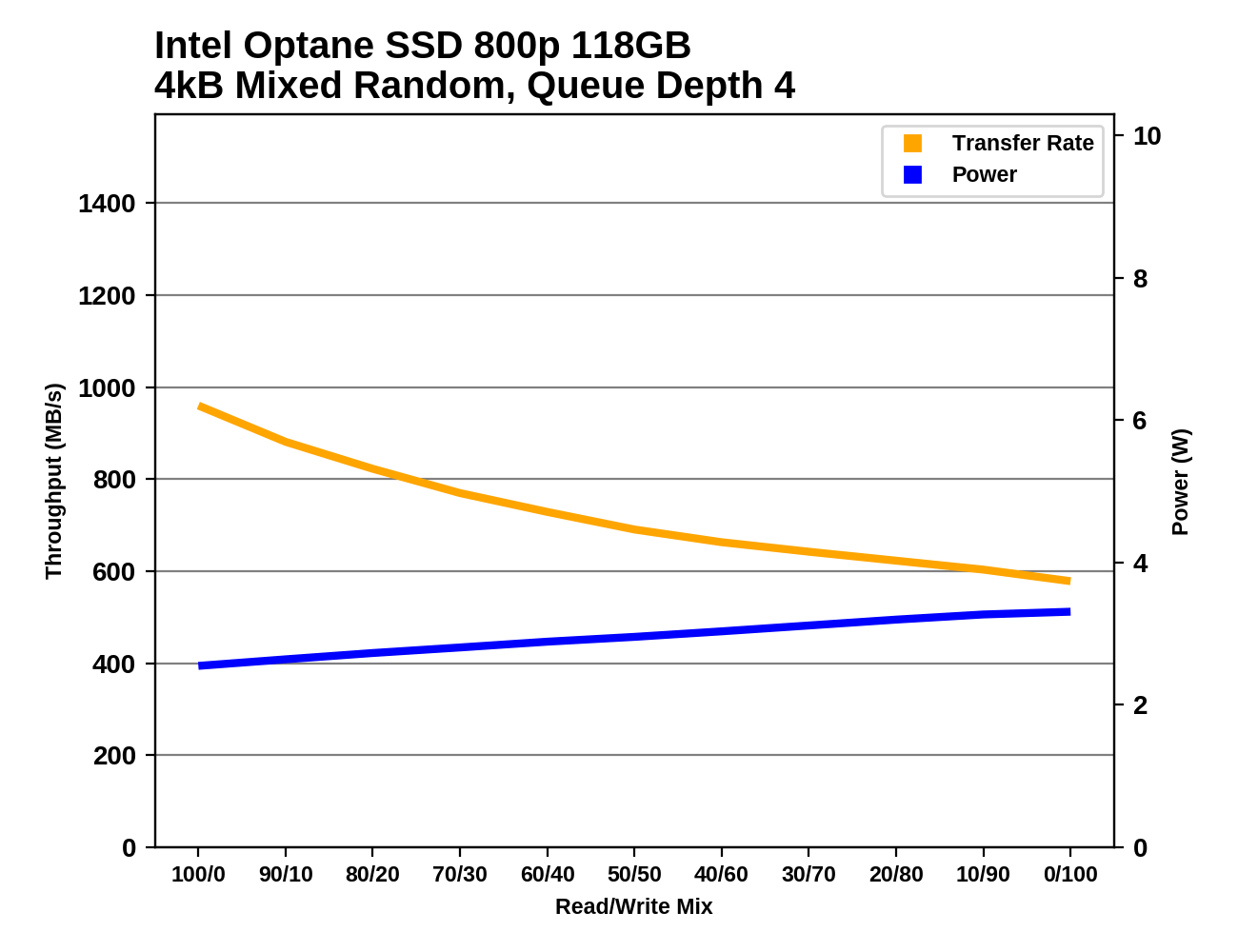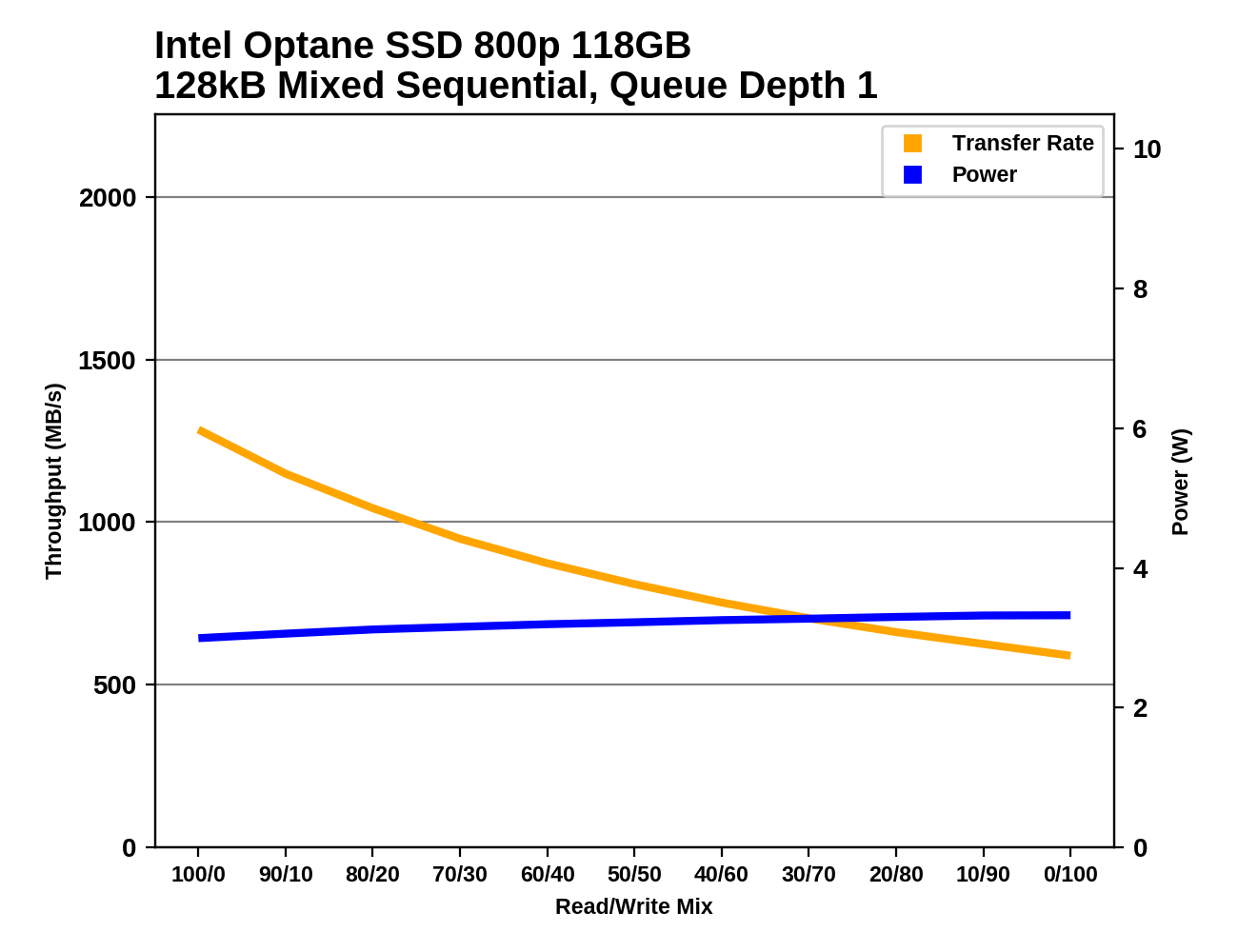The Intel Optane SSD 800p (58GB & 118GB) Review: Almost The Right Size
by Billy Tallis on March 8, 2018 5:15 PM ESTMixed Random Performance
Our test of mixed random reads and writes covers mixes varying from pure reads to pure writes at 10% increments. Each mix is tested for up to 1 minute or 32GB of data transferred. The test is conducted with a queue depth of 4, and is limited to a 64GB span of the drive. In between each mix, the drive is given idle time of up to one minute so that the overall duty cycle is 50%.

The Optane SSDs put even Samsung's best NVMe SSDs to shame on the mixed random I/O test. The 800p is a little more than half as fast as the 900p, which is plenty to put it far out of reach of the flash-based SSDs.

The Optane SSD 800p takes first place for power efficiency on the mixed random I/O test, with the 58GB model having a slight advantage over the 118GB due to the lower power consumption of operating half as many 3D XPoint dies. The flash-based SSDs come close to matching the efficiency of the Optane SSD 900p, but are far behind the 800p.
 |
|||||||||
With no write buffering, the Optane SSDs show a steady decline in performance as the proportion of writes increases, with no spike in performance at the end as is typical of flash-based SSDs with aggressive write combining. The 800p shows a more pronounced reduction in performance than the 900p, while the 900p's power consumption climbs more.
Mixed Sequential Performance
Our test of mixed sequential reads and writes differs from the mixed random I/O test by performing 128kB sequential accesses rather than 4kB accesses at random locations, and the sequential test is conducted at queue depth 1. The range of mixes tested is the same, and the timing and limits on data transfers are also the same as above.

With only a PCIe x2 interface and sequential write speeds that only use a fraction of that bandwidth, the Optane SSD 800p is actually performing pretty well on the mixed sequential I/O test. The 800p has the same average performance as Samsung's fastest TLC SSD, and offers more than two thirds the performance of the Samsung 960 PRO.

The power efficiency of the Intel Optane SSD 800p is second only to that of the Samsung 960 PRO. The 800p's efficiency score is far above the 900p and the low-end NVMe SSDs.
 |
|||||||||
As with the mixed random I/O test, the Intel Optane SSD 800p shows a steady decline inn performance as more writes are added to the mix. The decline is steeper than the one shown by the 900p. Power consumption increases very slightly over the course of the test but still stays within the rated maximum.










116 Comments
View All Comments
0ldman79 - Thursday, March 8, 2018 - link
That is a pretty significant limitation.With SSD's a lot of us have small to mid sized SSD as a boot drive and practically everything else resides on a spinner.
If Optane can't cache the secondary drive then it is of less use to me than even the Kaby Lake and above limitation. That means that even if I built a Kaby Lake or Coffee Lake I still won't get any benefit on the anything aside from the OS. My games are all installed on a mechanical drive.
Lolimaster - Friday, March 9, 2018 - link
Crucial MX500 2TB $499If you're an avid GTAV player, the 118GB should be a nice thing for the game intall, also your pagefile and install/profile/cache of firefox/chrome.
TheWereCat - Friday, March 9, 2018 - link
Micron 1100 2TB $370https://www.amazon.com/gp/aw/s/ref=is_s_ss_i_1_9?k...
Reflex - Friday, March 9, 2018 - link
Yup, grabbed one of those a few weeks ago, its a great drive for that price.hescominsoon - Friday, March 9, 2018 - link
I run only a micro 1TB ssd in my machine for everything. I have a couple of friends who are into video editing and they use a spinning disk for temporary storage...but that's about it..:)name99 - Friday, March 9, 2018 - link
Any decent SSD that wants to boost itself with a cache can ALREADY do so by using some of the MLC or TLC flash as SLC. And thereby run faster than Optane. And without requiring a separate controller and a separate Optane die.Optane is not buying you anything in the sort of market you describe.
Gunbuster - Thursday, March 8, 2018 - link
Capacity is still useless for any power user who would be shopping this.iter - Thursday, March 8, 2018 - link
It will be useful for pagefile spillover in case you have workloads that require more than the 32 or 64 gb of ram that most high end desktops come with.It will still massacre performance if you go paging, but it will be significantly better than nand, god forbid hdd.
jospoortvliet - Friday, March 9, 2018 - link
That's an interesting use case, the first I read that seems reasonably useful... But it would still need more performance to really make it worth it, and even then only when you don't care about costs at all and your platform simply doesn't support more ram. I mean, as long as the system can handle another ram dimm, you'd go for that even with the insane prices atm...iter - Saturday, March 10, 2018 - link
The thing is many systems can't. 64 is currently a limit for high end, 128 for HEDT.It could get better by raiding more drives, but .... that's not an option on high end platforms due to the low PCIe lane count. You will have to give up on running a GPU if you want to snap in 4 of those drives.